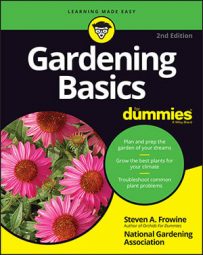Mulching flower beds is a good gardening habit. Mulch inhibits weed growth, holds in soil moisture, and moderates soil-temperature fluctuations. In cold-winter areas, mulching protects plant roots from winter cold and helps prevent frost-heaving, in which plants are literally pushed out of the ground by the natural expansion and contraction of the soil as it cools off and heats up. In hot-summer areas, it helps keep plant roots cooler
Some mulches are free, right in your own backyard; you can purchase others locally. Experiment to find out what you and your plants prefer. The following table provides the basic information you need to know about some of the more popular mulch options.
| Type of Mulch | Advantages | Concerns |
|---|---|---|
| Grass clippings | Is cheap, readily available, and easy to apply | Decays quickly, so you have to replenish it often; if you use weed killers on your lawn or nitrogen-heavy fertilizer, it may adversely affect other parts of the garden; can turn slimy if you apply more than an inch or so at a time; if the grass went to seed before you cut it, the grass seeds can germinate in your garden beds |
| Wood or bark chips | Looks neat and attractive; stays where you put it; is slow to decay | Pine bark mulch is fairly acidic, which you may or may not want for your garden; if you apply too deeply or apply a deep layer up against tree and shrub trunks, you may create a hiding spot for a bark-damaging rodent, especially during winter |
| Decaying leaves | Smothers weeds very well; helps hold in soil moisture | Is not especially attractive; if it contains seeds, they can germinate and become a weed problem; if the leaves are soft, like maple leaves, the mulch can mat; if it's acidic (oak especially), it can lower your garden soil's pH |
| Compost | Is free and plentiful if you have your own compost pile; adds nutrients to the soil as it breaks down | Makes a good place for weeds to take hold; fresh compost (especially if it contains manure or grass clippings) can burn plants |
| Peat moss | Looks neat and tidy; is versatile — also functions as a soil amendment | Can be expensive; if dry, will repel water; becomes crusty over time |
| Straw | Is cheap and easy to apply | Is so light it can blow or drift away; may harbor rodents, especially over the winter months; isn't very attractive for ornamental plantings |
| Hay | Is cheap and easy to apply | May harbor rodents, especially over the winter months; isn't very attractive for ornamental plantings; probably contains weed seeds! |
| Gravel, pebbles, or stone | Has a nice, neat look (though not "natural"); is easy to apply; won't wash away easily and will last a long time; doesn't need to be replenished over the course of a season in colder climates | Can allow weeds to sneak through; provides no benefits to the soil |
| Plastic (garden plastic, black plastic, landscaping fabric) | Keeps weeds at bay; holds soil moisture and warmth in | Watering and feeding is hard (you need to cut openings for plants); can be difficult to apply unless you're doing an entire area at one time; isn't very attractive |
| Rubber (shredded rubber) | Doesn't attract insects; doesn't wash away; can be expensive | Highly flammable; fire is hard to extinguish; can release contaminants into soil when rubber breaks down |
If you're ready to start applying mulch to your garden, here's what you need to know to ensure you get the best possible use of your mulch:
When you plant: Applying mulch right after planting something is easy. Use a shovel or scoop with a trowel. Spread the mulch over the root-zone area but not flush up against a plant's base or main stem (which can smother it or invite pests or disease).
Depth depends on the sort of plant. Annuals and perennials are fine with an inch or so of mulch; shrubs, roses, and trees need 3 or 4 inches or more.
During the growing season: Add more mulch midway through the growing season or whenever you notice it's depleted. You may have to get down on your knees or wriggle around a bit as you try to deliver it where it's needed without harming the plant or its neighbors. Again, use less for smaller plants, more for bigger ones.
In the fall or for winter protection: Depending on the severity of your winters and the amount of snow cover you expect (a blanket of snow can act as a protective mulch, actually), you want to cover an overwintering plant well. You can cut down perennials first and then practically bury them under several inches of mulch. You shouldn't trim back shrubs and rosebushes at this time, but you don't have to be as careful as you were with midsummer mulching because the plant is no longer growing actively. For freezing winters, 6 or more inches around the base of these is good.

